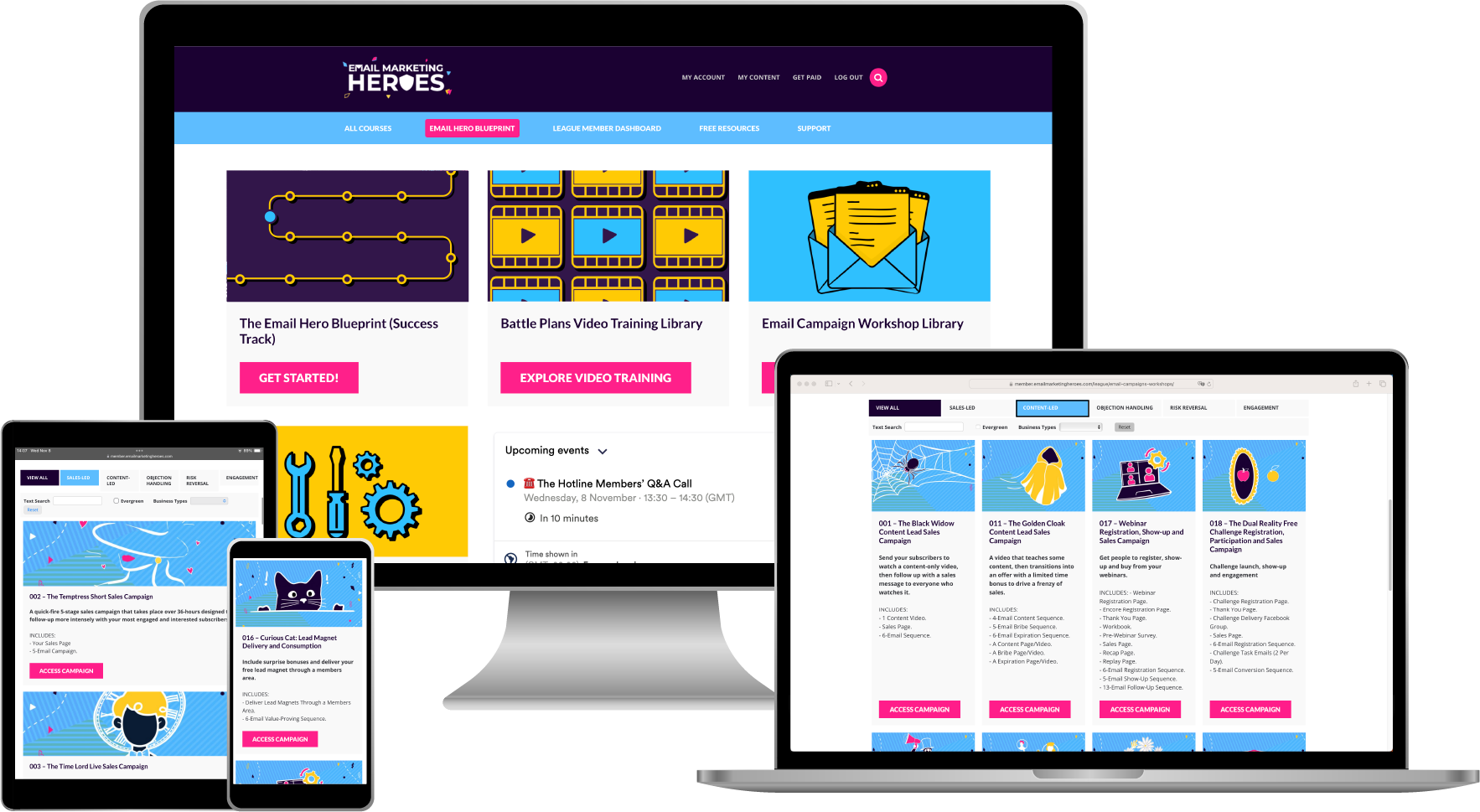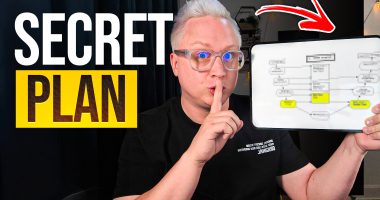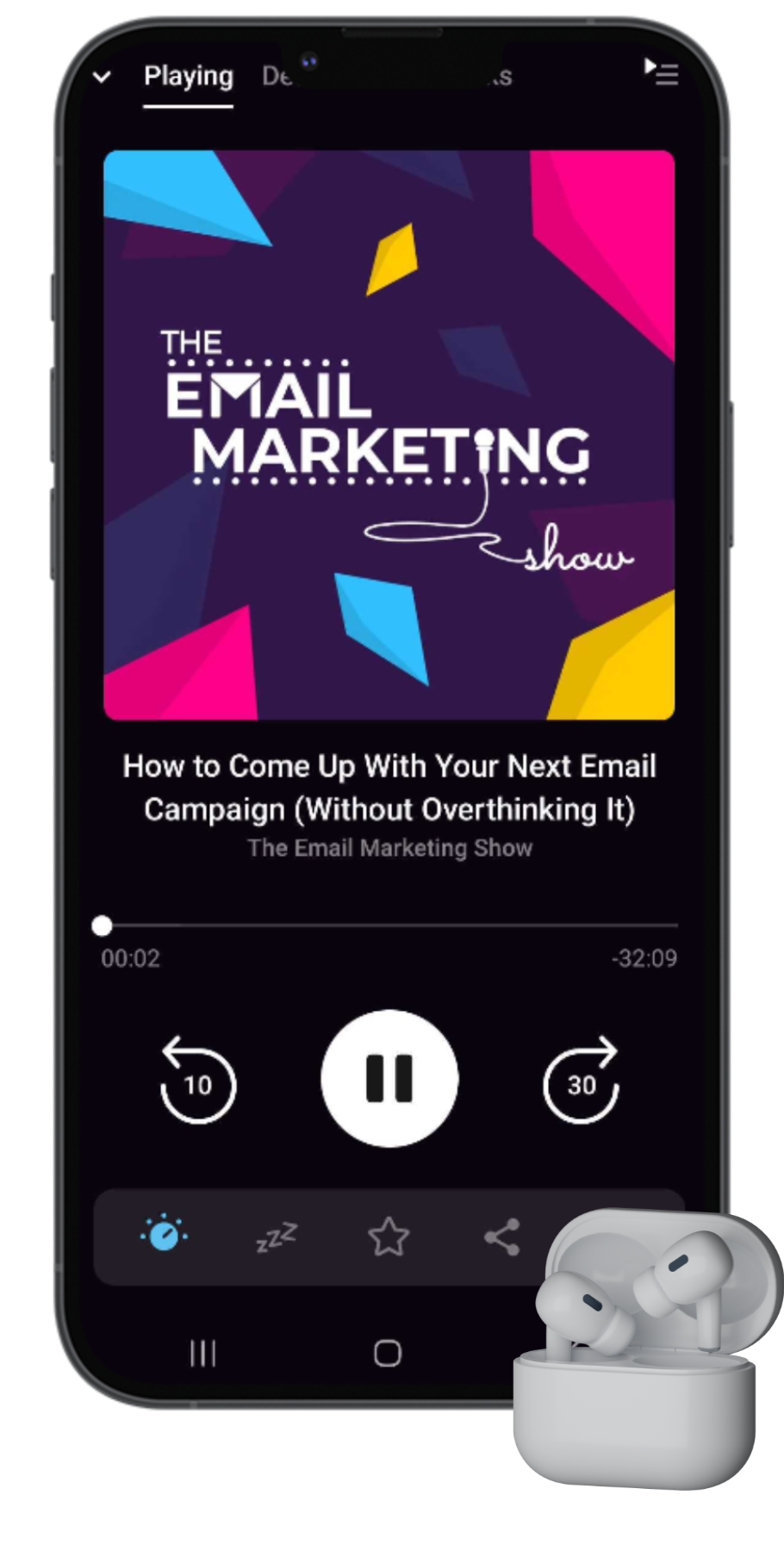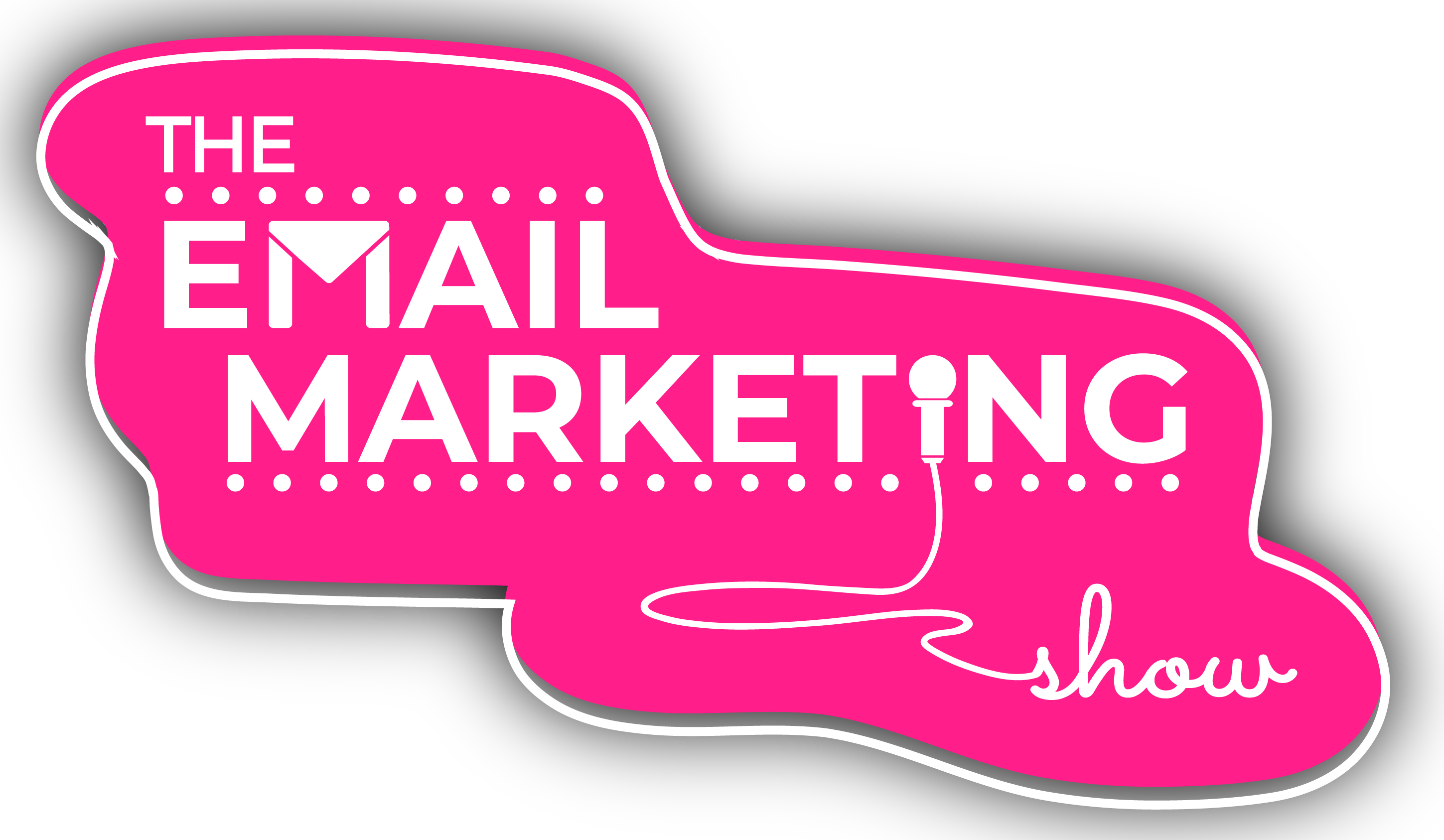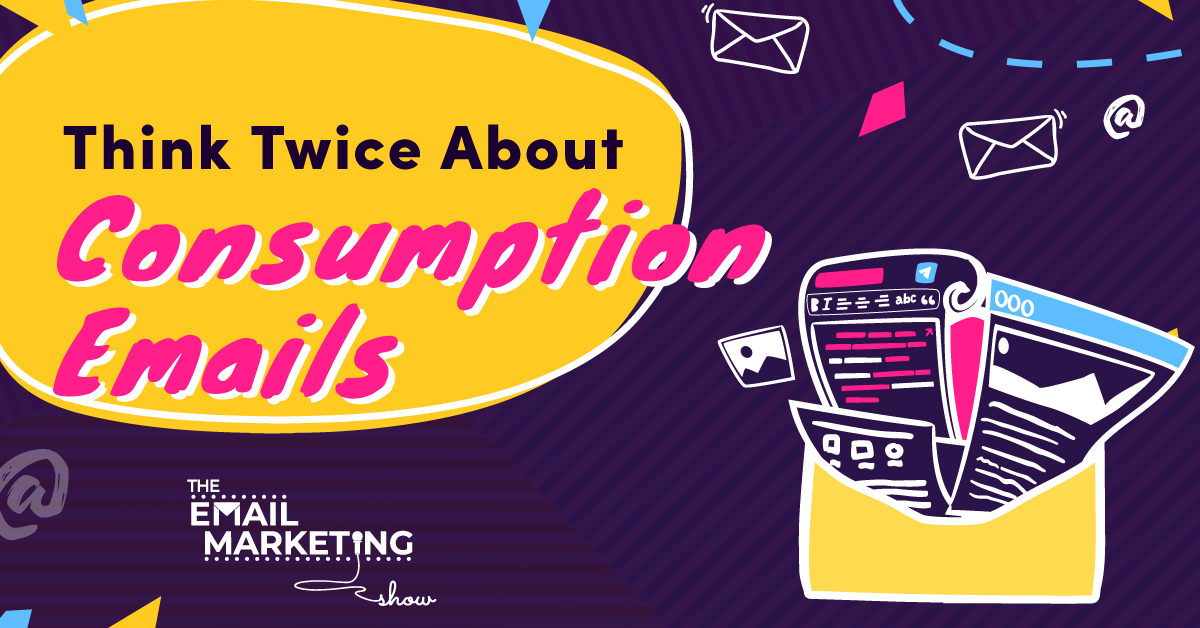
Why You Might Want to Think Twice About Consumption Emails
How do you encourage your audience to consume your content? Whether it's a free download or a paid course or a membership, how do you use your emails to inspire your subscribers or customers to use the amazing content they now have access to? Today we're covering content consumption by sharing an exclusive panel discussion with our friend Monica Snyder taken from our 2021 Inbox conference.
Monica is the CEO and Founder of Birdsong.co, and she's a true marketing genius! She’s great at funnels and ads, and she’s super analytical. In our conversation, we talk about consumption emails – the emails you send when someone opts in for your free lead magnet or buys something from you. Should you send these emails at all? Do they help? Or do they just get in the way?
Let's find out!
SOME EPISODE HIGHLIGHTS: (0:21) Come and join us at Inbox 2022 - for FREE! (5:50) Should you send consumption emails? (9:15) YES to sending consumption emails AND to offering upsells. (10:40) Consuming your content encourages people to buy more from you. (13:04) Do consumption emails work for both free and paid-for products? (19:21) Are consumption emails nagging? (22:32) How to upsell in your consumption emails. (23:56) Make use of custom fields! (27:45) Do free trials work? (33:35) Subject line of the week.
Come and join us at Inbox 2022 – for FREE!
Before we get into this conversation with Monica Snyder, we want to let you know that our Inbox conference is happening at the end of June 2022. And we’d like to invite you to join us for FREE!
Previously, tickets to this conference were $500, but this year we’re going to grow the event massively and make it into the biggest online email marketing party you can imagine. It's packed with amazing speakers, and it's fully online and live. Make sure you tune in (or read) next week, and we'll share more details about how to register.
Should you send consumption emails?
There’s definitely a view that if someone takes the time to consume our content, uses it, and gets results, they’re more likely to buy something else in the future. However, in our business, when someone opts in or buys something, we put them into a campaign to sell them on the next thing as soon as the next day.
For Rob, for example, when people download a free lead magnet from you, follow-up emails are more about trying to get them to click a link, rather than looking at the free content. Why? Because we think it's important to get them to subconsciously engage with us as a brand, rather than blindly consuming the content.
It's probably a controversial viewpoint, but Rob thinks we cannot always trust our subscribers or customers to implement our solutions. The onus to consume the content and get results is on them, and it's a fact that most people never consume the content they download or pay for. So if you’re waiting for the point where the person has consumed your content, you may be waiting forever!
YES to sending consumption emails AND to offering upsells
Monica, however, thinks we should definitely encourage people to consume our products. Part of our job as course creators, teachers, and information givers is to make sure we’re providing the information to ensure people do what they need to do with what we’ve given them. So for Monica, consumption emails are a big YES! But she also believes we should let people know about the next thing to buy. This is why Monica’s consumption emails lead straight into a sale.
For us, part of the problem is that in the past we found ourselves bashing our heads against a brick wall trying to get people to consume our content. That's how we reached the cynical viewpoint that you can lead a horse to water, but you can't make it drink. We're the kind of people who will unsubscribe from someone’s list after buying something if we feel we're being heavily forced to consume it. And that's because we don't like to consume content on someone else's timeframe.
Consuming your content encourages people to buy more from you
Having said that, there are definitely places where consumption is important. First of all, sending consumption emails is less aggressive than the older way of pushing people to buy something else straight away. Also, if you help people consume your content (which they were excited enough about to opt-in for free or buy) they will get to experience how good your stuff is. They’ll be more like to buy more in the future.
So the way we teach our clients to encourage content consumption is by sending emails that remind people of how good the content is – regardless of whether they'll go and look at it or not. Because the number of people who opt-in for free content and never access it is astronomically high! So what we'll do in our emails is point out there's value inside whatever our subscribers or customers have downloaded or bought. And we tell them exactly where they can find it. So when they get an offer from us, they're also aware that they're already sitting on some good value.

The Top 10 Books To 'Power Up' Your Email Marketing
10 book recommendations that will improve all areas of your email marketing (including some underground treasures that we stumbled upon which have been game-changing for us).
Do consumption emails work for both free and paid-for products?
Monica consistently runs traffic to both her free and paid offers, so her focus with consumption emails is both on lead generation and paid customer acquisition.
However, with free downloads, she encourages her subscribers to reply to her and explain what their biggest pain point is. That's so she can see if she can help them and also use that language in her marketing. She has a follow-up email that she sends after she's delivered the content to check whether people received her product. She also asks for their thoughts – assuming they looked at it. And it's that assumption that normally prompts some people to go look at the content and then reply.
For her paid-for course (low-ticket offer), Monica sends a 5-day email consumption sequence before she starts pitching people the next product for 7 days. With this sequence, she tries to manage people's expectations rather than dropping the product and moving on to the next thing. She believes it's important to make sure people have good expectations around how long things are going to take or where there might be roadblocks. It’s more about managing her customers' mental states. So she will, for example, point out where people can find specific knowledge points. It's what we normally describe as ‘training your audience'.
Content consumption emails for your membership
While we probably have a bit of a cynical viewpoint when it comes to content consumption around one-time offers, we find they work for our membership, The League. We typically use consumption emails to push people into our members’ area so they can view what's available and click on some of the resources. And because we can track the clicks, we see a lot of sales coming from that activity.
Are consumption emails nagging?
Monica doesn’t think consumption emails are nagging as long as they’re well-written. But if emails are boring or bland, then people will unsubscribe – a clear sign your audience doesn't like them!
We think it’s important to think about the psychological stack in people's heads here. By the time someone goes back to their inbox after downloading or buying something from you, a lot has happened. So within the first email, you need to be reselling them on the benefit of why they wanted your product in the first place.
After that, if you keep asking your subscribers if they've consumed your things, you probably do come across as nagging! But if the emails are valuable (if you’re soft teaching some of the points in your course, for example), then they can’t be considered annoying.
So use your emails to share some teachings but also remind your audience of the reasons why they want to learn your solution, which is why they downloaded your content or bought it in the first place. When your audience realises they're sitting on good, valuable content, their goodwill goes up – they feel like they've made a good decision. The key, we believe, is that your consumption emails resell people what they already bought.
How to upsell in your consumption emails
Monica also added that you should use your consumption emails to let people know about any products you have that could further help them. If they want to solve their problem faster or better or go deeper into the solution, then you have other products, and you can pitch them to your audience. So if all they have right now is a free download, then you pitch the paid offer to them. And you present that as the next or advanced level.
As we always say, email should never be used as a notification. You should always weave your consumption emails in with the style of your everyday emails. So our emails typically have a story or lesson of some description and then an offer and a call to action. And it’s easy enough to make the call to action an invitation to go and consume the content they downloaded or bought.
Make use of custom fields!
Recently we had someone get in touch to say they received 4 emails from us on the same day. Initially, we thought that wasn’t possible. But then we investigated and realised they had. And we’d advise you to also look into this for your own list – it's really easy to make that mistake!
And it was happening to Monica too… until she found the perfect technical solution to this – custom fields! Monica uses the custom fields in her autoresponder software to ensure she doesn't send too many emails to the same person in close succession. She does this by adding a date and time stamp for the last time people received a certain email. That way, she won't be sending another email to the same person for a certain timeframe.
Monica also uses custom fields to calculate lifetime value. So anytime someone buys from her, their purchase goes into the lifetime value custom field. And she uses this information to make decisions in other email sequences.
Do free trials work?
We found that when people pay money towards a product (rather than simply parting with their email address), content consumption is usually higher. But that’s no guarantee. Between us and Monica, we have plenty of examples of people who invested thousands in a product and didn’t consume it at all!
And this brings up an interesting point around free trials, which are a great conversion strategy as long as you make the offer work. When doing free trials, content consumption is everything. So you absolutely need a conversion sequence because if people aren’t getting into your free trial, then they won’t be upgrading to the paid-for offer either.
Free trials work, but you have to make them work in your style – they need to feel comfortable for you as a sender. Test things out and see what works for you, as it’s always going to depend on circumstances as well. The key is to do what works for you and your audience. Just remember though, as Monica says, that you use emails to sell and build relationships. And consumption emails fit perfectly with these objectives.
Subject line of the week
This week’s subject line is “Woof, woof?” It was an email about dogs and barking. Rob isn’t even sure why that worked! But… it's not a sentence and there’s no context, so that's probably why it worked a treat for us. Because people wanted to know what the email was all about, and it triggered that curiosity.
Useful Episode Resources
Related episodes
Onboarding Emails Examples for your Online Course.
Testimonials – how to write and collect them automatically to bring in more sales with Monica Snyder.
What Emails Should You Send Your Paying Members? with Mike and Callie from Membership Geeks.
FREE list of the top 10 books to improve your email marketing
If you want to write better emails, come up with better content, and move your readers to click and buy, here's how. We put together this list of our Top 10 most highly recommended books that will improve all areas of your email marketing (including some underground treasures that we happened upon, which have been game-changing for us). Grab your FREE list here.
Join our FREE Facebook group
If you want to chat about how you can maximise the value of your email list and make more money from every subscriber, we can help! We know your business is different, so come and hang out in our FREE Facebook group, the Email Marketing Show Community for Course Creators and Coaches. We share a lot of training and resources, and you can talk about what you're up to.
Try ResponseSuite for $1
This week's episode is sponsored by ResponseSuite.com, the survey quiz and application form tool that we created specifically for small businesses like you to integrate with your marketing systems to segment your subscribers and make more sales. Try it out for 14 days for just $1.
Join The League Membership
Not sick of us yet? Every day we hang out in our amazing community of Email Marketing Heroes. We share all of our training and campaigns and a whole bunch of other stuff. If you're looking to learn how to use psychology-driven marketing to level up your email campaigns, come and check out The League Membership. It's the number one place to hang out and grow your email marketing. Best news yet? You can apply everything we talk about in this show.
Subscribe and review The Email Marketing Show podcast
Thanks so much for tuning into the podcast! If you enjoyed this episode (all about encouraging content consumption with your emails) and love the show, we'd really appreciate you subscribing and leaving us a review of the show on your favourite podcast player.
Not only does it let us know you're out there listening, but your feedback helps us to keep creating the most useful episodes so more awesome people like you can discover the podcast.
And please do tell us! If you don't spend time on email marketing, what do you really fill your working days with? We'd love to know!

